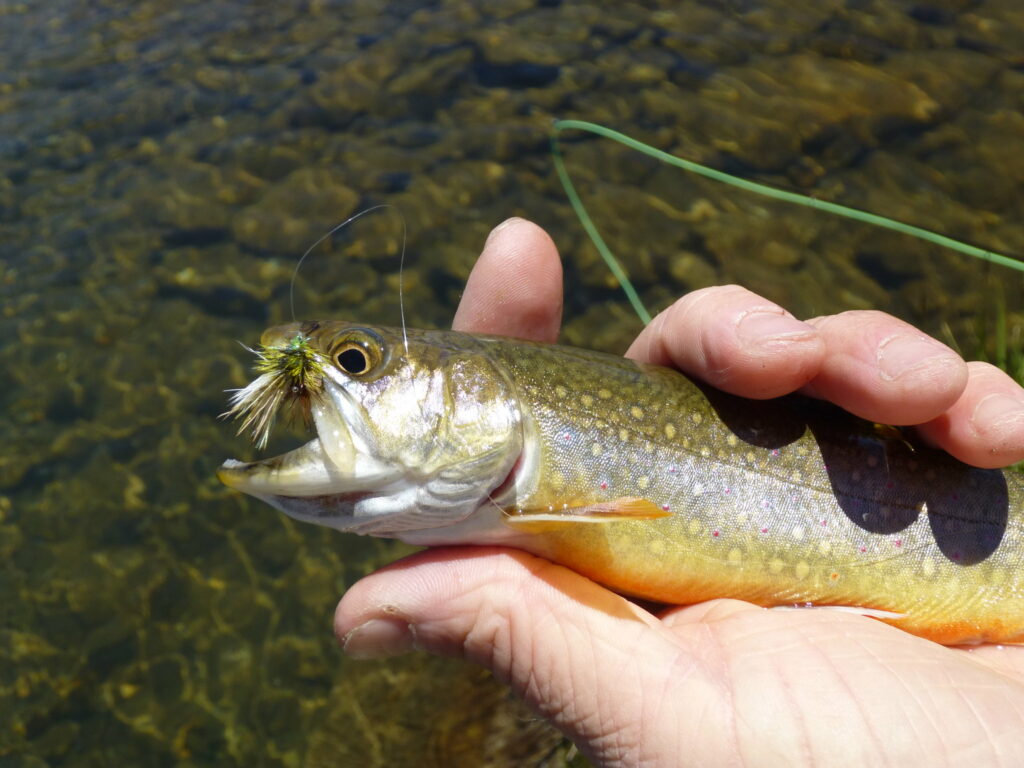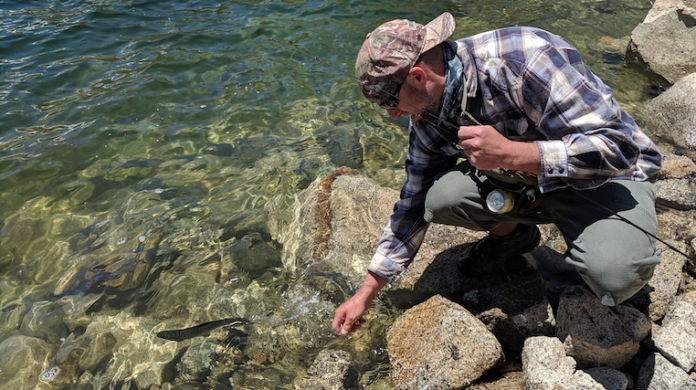
From mid- to late-summer following a light winter, these areas are prime real estate
BY MIKE STEVENS
MAMMOTH LAKES – Show up at any Eastern Sierra lake, and at least one angler is going to posted up at the inlet. They’re like hummingbird feeders for trout fishermen, unfortunately. But it is for good reason: they’re almost always productive areas.
They’re the locations that have guys strapping a headlamp on and bolting out to at 4 a.m. to stake their claim. It’s even crazier during the opener, when some anglers set up shop at their favorite inlet on Fishmas Eve and sit there overnight so they’re not only exactly where they want fish, but so that first cast is going out the second it’s legal to send it. The good news is, taking advantage of these spots is not reserved for the earliest riser you grumbled about when you showed up and he or she was already there.
The reasons anglers make such an effort to reenact the Land Run of 1893 to drive their stakes (rod holders) into the coveted territory adjacent to a lakes’ creek inlet can vary. For many, it could be for aesthetic reasons. Moving water has always been cool, be it below the deck of a primo cabin, a backyard fountain or a lazy river around the pool of a Vegas hotel. Even campers that don’t fish want to pitch the tent in those creekside spots that get grabbed first, and it’s not just for easy access to a 5-gallon fill-up for washing pots and pans. It could also be something that could be extracted from our DNA back to the preferred hangouts of indigenous people all over the planet or cavemen. For some, it’s actually because they know inlets produce fish.
Even when the reason for the occupation is fishing, a guy doesn’t have to be standing on top of an inlet like a kook in a SeaSwirl tied off to a kelp paddy make use of it. In many cases, you don’t even have to be within casting range of an inlet, in others, a casual observer might not think you were working the inlet at all.
Not all inlets are created equal
Some Eastern Sierra Lakes have such significant creek inlets, they appear in WON’s general season fishing reports on an almost weekly basis. Those are almost always where a named creek is dumping a significant amount of water into a lake. Rush Creek into Silver and Grant lakes, the inlet at Convict, South Lake, George and Crowley each have a bunch of them as does Rock Creek Lake, Virginia Lake and so on. Basically, if you pick up a Xerox copy of a map of a lake’s top fishing spots in the General Store, they’ll appear on it. Those are the ones anglers are going do get up at zero-dark-thirty to jump on, but that’s not the only option.
As far as fishing is concerned, inlets can be anything from smaller unnamed creeks, runoff from snowmelt that won’t exist a month later, trickles from a local spring, or even a quick hitter resulting from a high-country thunderstorm. Those are all gold, and a lot of the tim they get passed up by trouters on a mission to get to something more substantial.
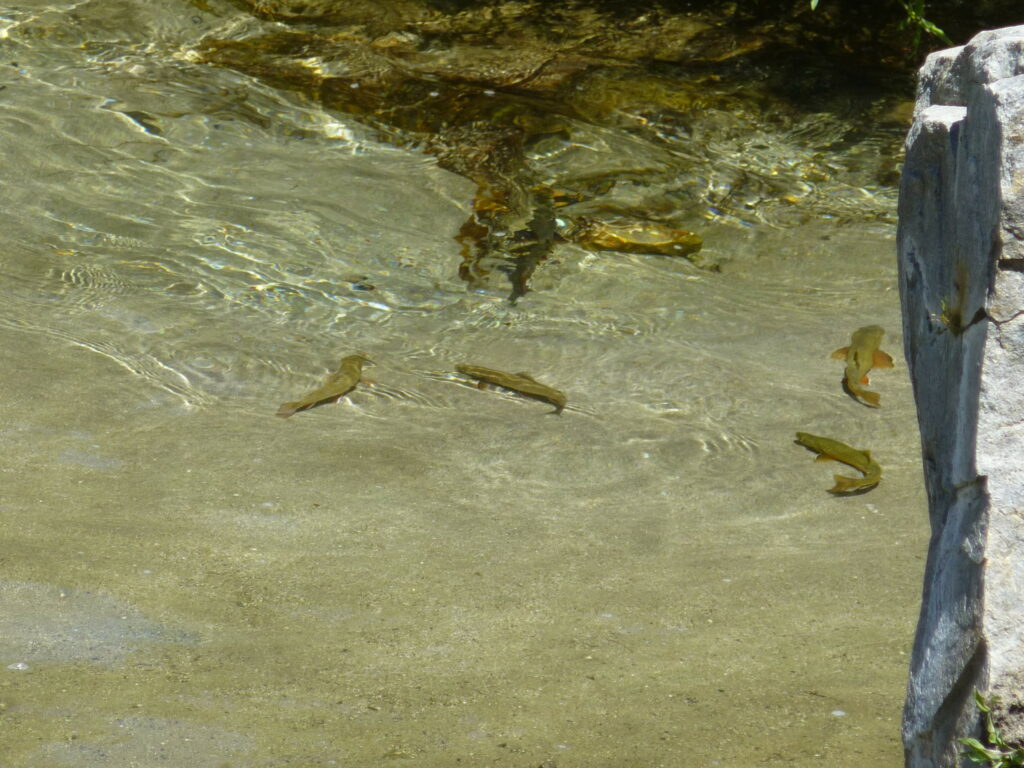
Another thing to keep in mind is the effect primary inlets have on what’s going on below the surface, and for how far offshore. Current doesn’t just leave the creek, hit the lake and end there. It continues indefinitely, all the way down to micro currents found way offshore and sometimes in very deep water, and trout will absolutely stick their noses right in it.
There’s also usually a creek channel along the bottom where the stream may have flowed for centuries before man threw in a dam and created a lake. Crowley Lake is a good example of this, where you’ll see float tubes and boats working the same invisible path hundreds of yards offshore. Those anglers are working the channel dug by the Owens River, McGee Creek, Hilton Creek and so on.
Why trout dig them
The basic reasons inlets of any kind produce trout are no secret to even casual Sierra trout anglers. For starters, they serve as a liquid conveyor belt delivering a wide array of food ranging from aquatic and terrestrial insects to trout fry, crustaceans and escapee nightcrawlers and broken-off salmon eggs. That buffet can be a sampling of items from whatever that creek meanders through for who knows how many miles, while the rest of the lake only has whatever already lives in the lake and what falls in. So, it doesn’t take a Jeopardy champion to figure out why trout tend to hang out around the main ones.
Trout dig cool, well-oxygenated water, and inlets deliver both. Not to go too far into geek mode, but it’s “disturbance” on the surface of water that brings dissolved oxygen into the equation, and depending on the amount of water coming in and how fast, the area of a lake benefiting from that effect can extend well beyond the range of a well-launched Thomas Buoyant from the ground zero where creek meets lake.
Oxygenated water – especially when paired with an optimal water temperature – makes active trout. Often times, you’ll see a different level of aggression in trout you catch around an inlet compared to say, fish you were catching on the other side of the lake on the same day. If it’s runoff from snow melt, it’s usually significantly colder than water simply flowing from one lake to the next, but a lot of that depends on what point of the
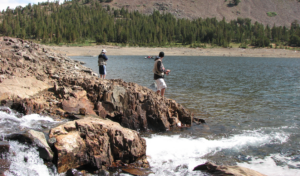
season it is. During peak runoff (usually in spring, but can be as late as mid-June following a heavy-snow winter) there’s so much snowmelt dumping into all the lakes, even the lake-to-lake flows are frigid. Later in the summer, they can have a bigger effect on the fishing when the overall water temp on a lake starts flirting with 70, and trout will either go deep, or seek out the coolest areas.
One thing I have personally noticed is these areas will also hold species other than what you are targeting. Usually, this occurs in drive-up lakes you know you’ll get rainbow trout in, but it can also hold browns and brooks even if you’ve rarely connected to them, if at all. Based on my own experience, it seems like brook trout are most likely to be the bonus species when fishing an inlet sourced backcountry lake, while browns will hang out around the mouth of a creek connecting one larger lake to the next.
That cooler water factor along with the dissolved oxygen thing gets multiplied significantly in the summer following a light-snowpack winter. The rest of this general season absolutely fits that bill.
How to attack them
One of the beauties of targeting trout relating to a lake’s inlet is that an angler can hit it with whatever method he wants, because it’s not a matter of how to technically attack a certain bite or structure or depth range. Lure chuckers can start off fan casting with Thomas Buoyants, Rooster Tails and Panther Martins – especially if you’re first to the spot. For those who start off with or fall back on plastics, minijigs should be worked from the surface down, from fast to slow. Crawling a jig or a Sierra Slammers Mini Swim along the bottom back toward an inlet can be very effective, and in that situation, it’s important to work the jig all the way back to shore, almost to your feet. That’s especially the case when it’s a snowmelt creek trout are relating to but hunkered down on the bottom in chilly water.
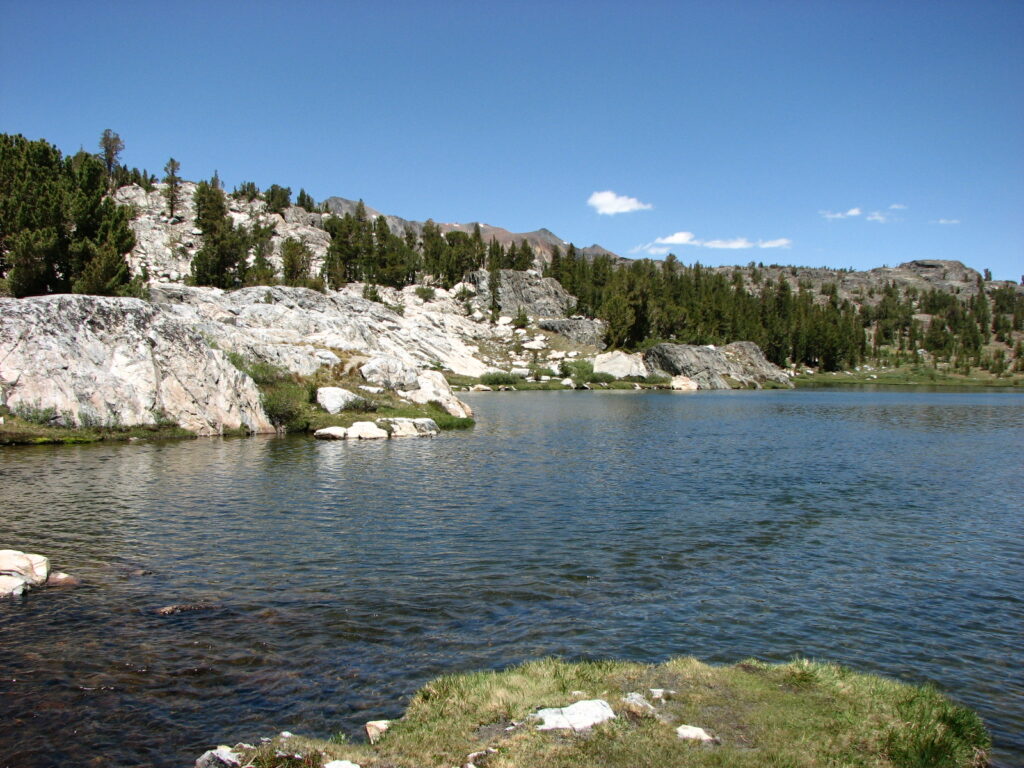
EVEN IF AN INLET IS SMALL it creates current that carries quite a ways offshore. Dry flies floating across that “nervous” water are often picked off by backcountry brook trout. WON PHOTO BY MIKE STEVENS
Bait dunkers can fish with Berkley PowerBait, Pinched Crawlers or Mice Tails on a short cast, and make each subsequent casts a little further than the last until biters are found. The Trout Worms or Mice Tails can be slowly jigged back in along the bottom, too. Trollers should work well offshore along the creek channel.
Fly fishers can take many angles of attack. Dry flies cast from the mouth of the creek and drift their bugs as far out as the current will take it. Streamers retrieved “upstream” back toward the creek also produces, and float tubers can work offshore and kick along the channel with streamers on intermediate fly-line. A fly-and-bubble can put gear (spin) anglers in the mix here as well, in fact, there are times where that particular rig will dramatically outfish all others deployed around an inlet.
Shop the outlet mall, too.
A lake’s outlet brings a lot of the same advantages of an inlet, and they should also be on the hit list. The water leaving the lake also creates current (toward shore), so it’s also going to have more dissolved oxygen than other areas of the lake. That moving water from deep to shallow will also funnel a variety of food options right into a trout’s face, so, keeping in mind a fish is almost always going to be facing current, switching your lure or fly barrage to an outside-in game plan is wise.
Many times on a backcountry lake, the outlet will feature a logjam, some packed-up debris piled up enough to walk across. Brook trout love hanging out right down in the snarled mess down below, so pitching jigs as close as you get to the sticks and letting them sink vertically to waiting fish can really pile them up. If the lake has golden trout in it, they might do the same thing but more likely offshore of the snarl in deeper water where they’ll also eat a minijig on the sink.
